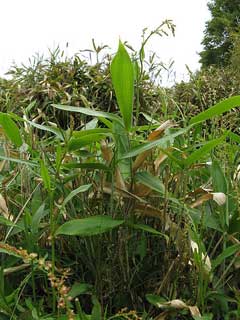 |
|
http://commons.wikimedia.org/wiki/User:KENPEI |
 |
| http://commons.wikimedia.org/wiki/User:KENPEI |
Translate this page:
Summary
Physical Characteristics

 Sasa veitchii is an evergreen Bamboo growing to 1.5 m (5ft) by 3 m (9ft).
Sasa veitchii is an evergreen Bamboo growing to 1.5 m (5ft) by 3 m (9ft).
See above for USDA hardiness. It is hardy to UK zone 8 and is not frost tender. It is in leaf all year. The species is hermaphrodite (has both male and female organs) and is pollinated by Wind.
Suitable for: light (sandy), medium (loamy) and heavy (clay) soils. Suitable pH: mildly acid, neutral and basic (mildly alkaline) soils. It can grow in semi-shade (light woodland). It prefers moist soil.
UK Hardiness Map
US Hardiness Map
Synonyms
S. albomarginata. Bambusa veitchii.
Plant Habitats
Woodland Garden Dappled Shade; Shady Edge; Ground Cover; Hedge;
Edible Uses
Edible Parts: Shoots Stem
Edible Uses:
Young shoots - cooked.
References More on Edible Uses
Medicinal Uses
Plants For A Future can not take any responsibility for any adverse effects from the use of plants. Always seek advice from a professional before using a plant medicinally.
None known
References More on Medicinal Uses
The Bookshop: Edible Plant Books
Our Latest books on Perennial Plants For Food Forests and Permaculture Gardens in paperback or digital formats.

Edible Tropical Plants
Food Forest Plants for Hotter Conditions: 250+ Plants For Tropical Food Forests & Permaculture Gardens.
More

Edible Temperate Plants
Plants for Your Food Forest: 500 Plants for Temperate Food Forests & Permaculture Gardens.
More

More Books
PFAF have eight books available in paperback and digital formats. Browse the shop for more information.
Shop Now
Other Uses
Hedge Hedge
A good medium high ground cover plant[200], it is a very good weed suppresser. Plants can be used as a low loose hedge[200].
Special Uses
Ground cover Hedge Hedge
References More on Other Uses
Cultivation details
Requires a good humus rich loam with ample moisture in the growing season[200]. Prefers partial shade, growing well in thin woodland. A very hardy plant, tolerating temperatures down to about -22°c. The leaf margins are damaged by even light frosts, this gives a distinctive white margin to the leaves but does not otherwise damage the plant[195]. This species is notably resistant to honey fungus[200]. Plants only flower at intervals of many years. When they do come into flower most of the plants energies are directed into producing seed and consequently the plant is severely weakened. They sometimes die after flowering, but if left alone they will usually recover though they will look very poorly for a few years. If fed with artificial NPK fertilizers at this time the plants are more likely to die[122]. The rhizome is gently running. The plant is very invasive but fairly easy to control.
References Carbon Farming Information and Carbon Sequestration Information
Temperature Converter
Type a value in the Celsius field to convert the value to Fahrenheit:
Fahrenheit:
The PFAF Bookshop
Plants For A Future have a number of books available in paperback and digital form. Book titles include Edible Plants, Edible Perennials, Edible Trees,Edible Shrubs, Woodland Gardening, and Temperate Food Forest Plants. Our new book is Food Forest Plants For Hotter Conditions (Tropical and Sub-Tropical).
Shop Now
Plant Propagation
Seed - if possible, surface sow the seed as soon as it is ripe in a greenhouse at about 20°c. Stored seed is best sown as soon as it is received. Do not allow the compost to dry out. Germination usually takes place fairly quickly so long as the seed is of good quality, though it can take 3 - 6 months. Prick out the seedlings into individual pots when they are large enough to handle and grow them on in a lightly shaded place in the greenhouse until large enough to plant out, which could be a few years. Plants only flower at intervals of several years and so seed is rarely available. Division in late spring as new growth commences. Take large divisions, trying to cause as little root disturbance to the main clump as possible. Grow them on in light shade in a greenhouse in pots of a high fertility sandy medium. Mist the foliage regularly until plants are established. Plant them out into their permanent positions when a good root system has developed, which can take a year or more[200]. Divisions of less than 5 - 6 culms rarely succeed[200].
Other Names
If available other names are mentioned here
Native Range
TEMPERATE ASIA: Japan (Honshu (west), Kyushu, Shikoku)
Weed Potential
Right plant wrong place. We are currently updating this section.
Please note that a plant may be invasive in one area but may not in your area so it's worth checking.
Conservation Status
IUCN Red List of Threatened Plants Status :

Growth: S = slow M = medium F = fast. Soil: L = light (sandy) M = medium H = heavy (clay). pH: A = acid N = neutral B = basic (alkaline). Shade: F = full shade S = semi-shade N = no shade. Moisture: D = dry M = Moist We = wet Wa = water.
Now available:
Food Forest Plants for Mediterranean Conditions
350+ Perennial Plants For Mediterranean and Drier Food Forests and Permaculture Gardens.
[Paperback and eBook]
This is the third in Plants For A Future's series of plant guides for food forests tailored to
specific climate zones. Following volumes on temperate and tropical ecosystems, this book focuses
on species suited to Mediterranean conditions—regions with hot, dry summers and cool, wet winters,
often facing the added challenge of climate change.
Read More
Expert comment
Author
(Carrière.)Rehder.
Botanical References
1158200
Links / References
For a list of references used on this page please go here
Readers comment
© 2010, Plants For A Future. Plants For A Future is a charitable company limited by guarantee, registered in England and Wales. Charity No. 1057719, Company No. 3204567.